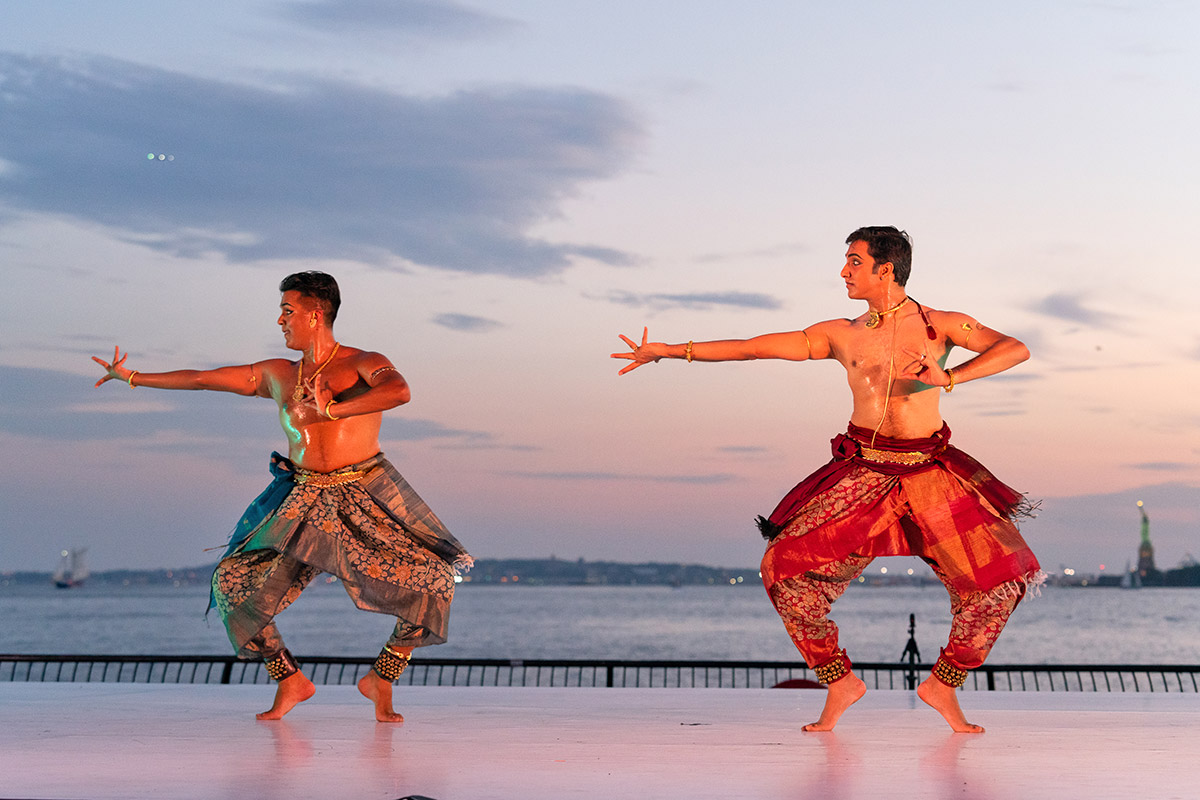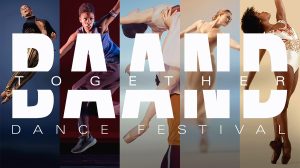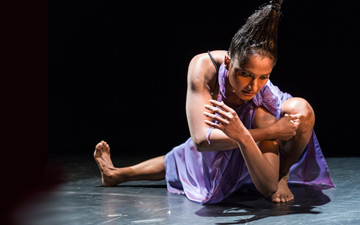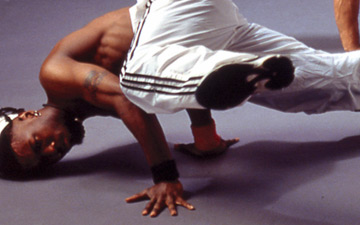
© Steven Pisano. (Click image for larger version)
Battery Dance Festival
India Independence Day program: Parul Shah Dance Company, Kasi Aysola & SaiSantosh Radhakrishnan, Swathi Gundapuneedi-Atluri, Maya Kulkarni & Dancers
★★★★✰
New York, Robert F. Wagner, Jr. Park
15 August 2021
batterydance.org/battery-dance-festival
The Battery Dance Festival’s Indian program is always a highlight of the festival. This year, on the 75th India Independence Day in the 40th year of Battery Dance Company’s annual festival, a typically rich program featured Indian artists based locally, in Brooklyn, New Jersey, and Maryland, in styles ranging from Kathak to Bharatanatyam to Kuchipudi. Dances mixed traditional forms with innovations, but the distinctive complexities of Indian dance forms came to the fore.
In 2020 the festival was virtual and Indian dance was prominently and well represented, and I also was much taken with a program of African artists based in Africa, some of whom were not only exceptional, but new to me. This second pandemic year there is also a virtual component from around the world, and the six days of live performances were also livestreamed and available for ten days.
Rajika Puri once again introduced the artists. Though she’s often a curator, she said this year the curation was entirely by Jonathan Hollander, director of Battery Dance, a longtime enthusiast for Indian dance and with a sharp eye. The program had an effective arc, complementing the setting’s arc from daylight to sunset (very dramatic the evening I was there) to night. The stage overlooks the breadth of New York harbor, with the Statue of Liberty directly south. Boats pass by, sometimes clearly aiming to take a look. And a small sailboat lingered during the dramatic last dance by three women, choreographed by Maya Kulkarni, passing back and forth as if to catch it all.
The dancing began with Yugal, a duo choreographed by Parul Shah’s Kathak guru Kumudini Lakhia. The music was recorded. Mohip Joarder began with slow moves, arm reaches with well-defined hands, some fast steps and occasional jumps, slow turns with chopping arms. Parul Shah joined him and they danced together, sometimes with quick Kathak footwork, their ankle bells ringing. Slowly rising arms continued to be a motif, often with unison gestures. Not everything seemed strictly Kathak – at one point they boureed across the stage. Shah was clearly invested in the piece; Joarder was good, but seemed to be intent rather than authoritative. Unison rapid feet led, not long after, to a slow, deliberate pointing to the sunset.
Parul Shah introduced a new duet that she choreographed, dancing with Jin Won. For this there was live tabla and sitar playing, the only live music this evening other than a duo, Eventually Epic, with guitar and songs, often from Bollywood, that played between the dance artists. The women were barefoot, but without ankle bells, and the music was at first modern and atonal, but later featured a more clearly North Indian sound with sitar runs and tabla beats. The dance, too, combined Kathak moves with other approaches. The women, Shah in soft orange, Won in sage green, faced each other, palms out, or got on one knee. Facing each other again, they made fast Kathak flutters with their feet. It was a graceful, pleasant piece rather than a show of Kathak excitement.

© Steven Pisano. (Click image for larger version)
The succeeding dances did supply plenty of intensity, beginning with a Bharatanatyam duet, Water, also a premiere, by Kasi Aysola, dancing with another man, SaiSantosh Radhakrishnan. The two, bare-chested, one, Aysola, in blue figured pants, the other in red, jumped and turned and covered space in unison in a mobile, contemporary, but decidedly Bharatanatyam way, waving fingers to suggest rain. Aysola often returned to this rain motif throughout Water, reminding us of its presence on the land, and sometimes varying his fingers in interesting ways – water comes down in different forms and intensities.
Water is a dance to a poem, well sung in the recording, that traces the paths of the water cycle and its effect on earth’s life, plants, and animals, including humans. Sections invoked the poem through mime and dance, so that I did feel we were in a forest or a garden, did see suggestions of animals, and a caressing embrace that represented human love. Retreating sections of pure dance marked intervals between parts of the poem. Separately or together, apart or in conjunctions, the men danced Water in a vibrant and satisfying way, dancing with passion as the setting sun turned red.
As Rajika Puri reminded us, Kuchipudi originated as dance drama by men in the southern state of Andhra, and in the twentieth century became a solo form often danced by women. Swathi Gundapuneedi-Atluri danced Ananda Tandavam with the kind of consummate assurance and skill that made her depiction of Lord Shiva and his consort Parvathi entirely convincing.
She alternated between Shiva’s power and Parvathi’s lyrical grace, using her expressive face, her hands, her arms, her subtly gliding head, her whole body, to convey these deities and their relationship. Whenever, periodically, she filled up her chest and her face, I felt Shiva’s overwhelming presence. She knelt and lifted up her head expressively, made interesting dipping turns, danced fully, superbly, to syllables or to the recorded song. The program suggests that the excellent music represented a constellation of gods – Vishnu drumming the mridangam, Indra on flute, Brahma on cymbals, Saraswathi on veena, and Lakshmi singing. And Swathi Gundapuneedi-Atluri encapsulated them all with her dance.

© Steven Pisano. (Click image for larger version)
Kundalini Rising and Kavacham, choreographed by Maya Kulkarni for three women, was announced as two pieces, but fused imperceptibly into one. The vocabulary was also a seamless fusion of Bharatanatyam, yoga, and acrobatic energies as the dancers moved from an offering to the rising sun to invoking Brahma, Vishnu, and Shiva as one, and as separate powers.
The three women moved into various formations and patterns, sometimes balancing on one leg, sometimes joining to make an intertwined being. Mesma Belsaré was at the head of a chariot formation for the rising of the sun, while Aishwarya Madhav and Aishwarya Sriram held on behind. Belsaré, the tallest of the dancers, and particularly assured, was often the focus throughout. She offered subtleties, like little slides of the head or intense eye movements, as well as power.
As a triumvirate of gods they had to do difficult things in intricate combinations. They balanced on one leg, at the back of each other, arms flung out, heads moving. They stamped in unison and turned together. In many formations they interlinked, one on the back of the other, the first standing, the others in lower positions. Arms sprouted, forming many-armed deities, merging their powers. They had to lean way back – a woman might fall beneath another. These complicated, acrobatic enmeshings seemed difficult, but were performed expertly. Kulkarni’s choreography was effective and cumulative. Near the end, Belsaré balanced on one leg while the two Aishwaryas raced around her. There were impressive unison stamps in second position, and more unisons to convince us that these three gods were present in their dancing powers.

















How lovely that you wrote so well about the Indian Dance programming, dancers, dances. Just wanted to reach out and thank you. Have posted (a link to) the article on my page on Facebook – which I note you are NOT on!
Thank you and so glad you liked Susanna’s review.